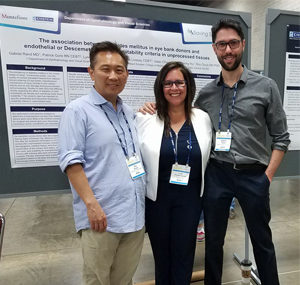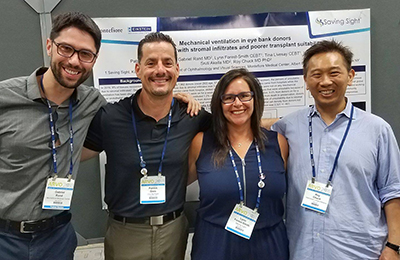
Dr. Roy Chuck, Lynn Forest-Smith and Dr. Gabriel Rand at ARVO 2018
With the rise in diabetes, discussion over the quality of corneal transplant tissue from diabetic donors in US eye banks is of concern. According to new research presented this week at the 2018 Annual Meeting of the Association for Research in Vision and Ophthalmology in Honolulu, scientists are one step closer to proving the suitability of the tissue from diabetic donors.
Through the study, a retrospective analysis was conducted to determine if corneas from diabetic donors were more likely to be marked unsuitable for surgical use based upon poor Descemet membrane (DM) or endothelial cell ratings.
This project, led by Gabriel Rand, MD, resident at the Albert Einstein College of Medicine Department of Ophthalmology and Visual Sciences, found that the presence of diabetes was not significantly associated with reduced transplant suitability. This study was the first in collaboration with Kansas City-based nonprofit Saving Sight’s donor data and is consistent with previous studies to support the continued preservation of the diabetic donor pool.
“Many cornea transplant surgeons are apprehensive about using grafts from diabetic donors because they believe the tissue to be of poorer quality. We analyzed the Saving Sight database and found that diabetes was not associated with differences in tissue quality across a number of eye bank suitability criteria. The research supports greater transplant utilization of tissue from diabetic donors,” said Dr. Rand.
Saving Sight Chief Business Development Officer Patrick Gore, RN, CEBT, Director of Business Development Lynn Forest-Smith, and Chief Operating Officer Tina Livesay were co-authors on the study. As an eye bank that facilitates eye donation for transplant and research, Gore said Saving Sight is proud to support this project and to work in collaboration with Montefiore and Drs. Rand, Chocron, Hu, Akella and Chuck.

Dr. Gabriel Rand, Patrick Gore, Lynn Forest-Smith and Dr. Roy Chuck at ARVO 2018
“We appreciate partnering with such dynamic collaborators to further ophthalmic research. To paraphrase the great Helen Keller, we believe that working together we can always achieve so much more,” said Gore.
In addition to the diabetes study, the team also presented their findings on mechanical ventilation in eye bank donors and its association with poorer corneal transplant suitability at ARVO 2018.
These studies continue to advance innovation and research in corneal transplantation through collaboration between eye banks, medical centers, and researchers.
“Eye banks have traditionally had the essential role of supplying donor tissues that enable people to see,” said Dr. Rand. “Working with Dr. Chuck and Saving Sight has been an incredible opportunity for me to understand how in addition to this role, eye banks can also advance academic research in the field of ophthalmology.”
Abstracts:
Diabetes mellitus in eye bank donors does not impact corneal transplant suitability
Authors: Gabriel Rand MD, Isaac Chocron MD, Jimmy Hu MD, Patrick Gore RN CEBT, Lynn Forest-Smith CEBT, Tina Livesay CEBT, Roy Chuck MD PhD
Mechanical ventilation in eye bank donors is associated with poorer corneal transplant suitability
Authors: Patrick Gore RN CEBT, Gabriel Rand MD, Isaac Chocron MD, Lynn Forest-Smith CEBT, Tina Livesay CEBT, Sruti Akella MD, Roy Chuck MD PhD

